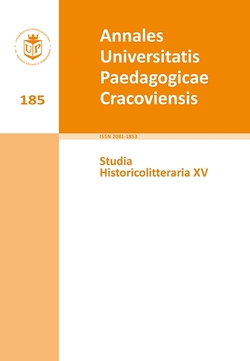Czy wojna jest dla dzieci? O obrazach wojny w literaturze dla najmłodszych
Hauptsächlicher Artikelinhalt
Abstract
Is war suitable for children? Images of war in children’s literature
I drew on poetics of space by Gaston Bachelard to describe the reality of war from a child’s perspective. War stories for children were depicted in following books: Zaklęcie na “w” (The w-word spell) by Michał Rusinek, Asiunia by Joanna Papuzińska, Czy wojna jest dla dziewczyn? (Is war suitable for girls?) by Paweł Beręsewicz and Wszystkie moje mamy (All my moms) by Renata Piątkowska.
Happy places, where children can cower and find shelter are typical features of Bachelard’s poetics of space. During the war cellars served as bomb shelters and they were also the places where adults and children looked for a hideaway and safety. Another determiner of poetics of space is a small - big opposition which is carried out e.g. by setting a small child against an adult, a strong German. This opposition is connected with good - bad or white - black dialecticc.
The phenomenology of roundness is the next determiner of poetics of space and it is exhibited in children songs and games. Even during the war children desired to have ordinary and happy childhood without fear. Warm embrace of parents and storytelling are also very important. The phenomenology of the hidden is a final determiner of poetics of space and it is expressed e.g. as additional packets which people sewed to their clothes to smuggle food and medicine or as special boxes, which served to transporting children from ghetto. Illustrations are very important, because they supplement the text.
During the war children must face up to a new reality. Instead of parents’ love, there are harsh rules of war.
Key words: war; children; bombing; ghetto; German;
Downloads
Artikel-Details

Dieses Werk steht unter der Lizenz Creative Commons Namensnennung - Nicht-kommerziell - Keine Bearbeitungen 4.0 International.
URHEBERRECHTE
Der Herausgeber der „AnnalesUniversitatisPaedagogicaeCracoviensis. StudiaHistoricolitteraria” ist zur Nutzung und Verbreitung aller in der Zeitschriftveröffentlichten Materialien auf Grundlage eines nicht ausschließlichen, zeitlich unbeschränkten Lizenzvertrags befugt, der im Voraus unbefristet mit jedem/r Autor/in des jeweiligen Werks für die im betreffenden Vertrag vereinbarten Nutzungsbereiche abgeschlossen wird.
POLITIK DES OFFENEN ZUGRIFFS
Die „AnnalesUniversitatisPaedagogicaeCracoviensis. StudiaHistoricolitteraria” sind eine Fachzeitschrift mit freiem Zugriff, dessen voller Inhalt kostenlos für Nutzer und Einrichtungen auf Grundlage einer nicht ausschließlichenCreativeCommons-Lizenz (CC BY-NC-ND 4.0) verfügbar ist. Die Nutzer/innen können die Artikel in dieser Zeitschriftohne vorherige Zustimmung des Herausgebers oder des/r Autors/in lesen, herunterladen, Kopien anfertigen, verbreiten, drucken oder zu Volltexten verlinken, insofern die Quelle des Zugriffs und der/die Autor/inder jeweiligen Publikation angegeben wird. Dies ist mit der BOAI-Definition des offenen Zugriffs konform (http://www.soros.org/openaccess).
Literaturhinweise
Bachelard G., Wstęp do poetyki przestrzeni, [w:] Współczesna teoria badań literackich za granicą, red. H. Markiewicz, t. 2, Kraków 1976.
Baluch A., Topofilie porządkiem dziecięcej lektury, [w:] tejże, Od form prostych do arcydzieła. Wykłady, prezentacje, notatki, przemyślenia o literaturze dla dzieci i młodzieży, Kraków 2008.
Beręsewicz P., Czy wojna jest dla dziewczyn?, il. O. Reszelska, Warszawa 2010.
Heska-Kwaśniewicz K., O wojnie i okupacji w literaturze dla młodych odbiorców. Rekonesans, „Guliwer” 2009, nr 1.
Heska-Kwaśniewicz K., Wojna jest dla dziewczyn, „Guliwer” 2010, nr 2.
Kowalska-Leder J., Doświadczenie zagłady z perspektywy dziecka w polskiej literaturze dokumentu osobistego, Warszawa 2009.
Papuzińska J., Asiunia, il. M. Szymanowicz, Warszawa 2013.
Piątkowska R., Wszystkie moje mamy, il. M. Szymanowicz, Łódź 2014.
Rusinek M., Zaklęcia na „w”, il. J. Rusinek, Warszawa 2011.
